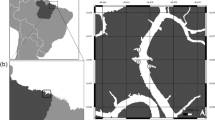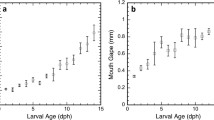Summary
The foraging behavior of Mesocyclops edax in artificial patches of high and low prey density was examined. In low density patches Mesocyclops swam in an irregular curvilinear path with little or no looping behavior. In high density patches Mesocyclops exhibited extensive horizontal and vertical looping behavior. Horizontal loops were performed in the normal hop and sink swimming mode, while vertical loops were associated with predator attacks on single prey items. Previous studies on terrestrial invertebrates revealed similar looping behaviors by predatiors and have suggested such looping behavior will increase the time a predator will spend in high versus low density prey patches. When food is patchily distributed and consumers are food-limited, the adaptive significance of remaining in a high density food patch may be substantial.
Similar content being viewed by others
References
Bainbridge R (1953) Studies on the interrelationships of zooplankton and phytoplankton. J Mar Biol Assoc UK 32:385–447
Banks CJ (1957) The behavior of individual coccinellid larvae on plants. Brit J Anim Behav 5:12–24
Beukema JJ (1968) Predation by the three-spined stickleback (Gasterosteus aculeatus L.). Behaviour 31:1–126
Chandler AEF (1969) Locomotory behaviour of first instar larvae of aphidophagous Syrphidae (Diptera) after contact with aphids. Anim Behav 17:673–678
Colebrook JM (1960) Some observations of zooplankton swarms in Windermere. J Anim Ecol 29:241–242
Curio E (1976) The ethology of predation. Springer-Verlag, New York, pp 250
Dagg M (1977) Some effects of patchy food environments on copepods. Limnol Oceanogr 22:99–107
Dagg MJ, Grill DW (1980) Natural feeding rates of Centropages typicus females in the New York Bight. Limnol Oceanogr 25:597–609
Dixon AFG (1959) An experimental study of the searching behaviour of the predatory coccinellid beetle Adalia decumpunctata (L.). J Anim Ecol 28:259–281
Dumont HJ (1967) A five day study of patchiness in Bosmina corregoni Baird in a shallow eutrophic lake. Mem Ist Ital Idrobiol 22:81–103
Emery AR (1968) Preliminary observations on coral reef plankton. Limnol Oceanogr 13:293–303
Fleschner CA (1950) Studies on searching capacity of the larvae of three predators of the citrus red mite. Hilgardia 20:233–265
Fryer G (1957) The feeding mechanism of some freshwater cyclopoid copepods. Proc Zool Soc Lond 129:1–25
Gerritsen J (1980) Adaptive responses to encounter problems. Am Soc Limnol Oceanogr Spec Symp 3:52–62
Gilbert JJ (1975) Polymorphism and sexuality in the rotifer Asplanchna, with special reference to the effects of prey-type and clonal variation. Arch Hydrobiol 75:442–483
Gilbert JJ, Williamson CE (1978) Predator-prey behavior and its effect on rotifer survival in associations of Mesocylops edax, Asplanchna girodi, Polyarthra vulgaris, and Keratella coclearis. Oecologia (Berl.) 37:13–22
Griffiths AM, Frost BW (1976) Chemical communication in the marine planktonic copepods Calanus pacificus and Pseudocalanus sp. Crustaceana 30:1–9
Hamner WM, Carleton JH (1979) Copepod swarms: attributes and role in coral reef ecosystems. Limnol Oceanogr 24:1–14
Hassell MP (1978) Arthropod predator-prey systems. Princeton Univ. Press Princeton 237 pp
Haury LR, McGowan JA, Wiebe PH (1978) Paterns and processes in time-space scales of plankton distribution. In: JH Steele (ed), Spatial pattern in plankton communities. Plenum Press, New York, p 277–327
Hebert PDN, Good AG, Mort MA (1980) Induced swarming in the predatory copepod Heterocope septentrionalis. Limnol Oceanogr 25:747–750
Holmes SJ (1909) Sex recognition in Cyclops. Biol Bull 16:313–315
Hunter JR, Thomas GL (1974) Effect of prey distribution and density on searching and feeding behavior of larval anchovy Engraulis mordax Girard. In: JHS Blaxter (ed), The early life history of fish. Springer, Berlin Heidelberg New York, p 559–574
Ivlev VS (1961) Experimental ecology of the feeding of fishes. Yale Univ Press, New Haven, p 302
Katona SK (1973) Evidence for sex pheromones in planktonic copepods. Limnol Oceanogr 18:574–583
Kerfoot WC (1978) Combat between predatory copepods and their prey: Cyclops, Epischura, and Bosmina. Limnol Oceanogr 23:1089–1102
Kittredge JS, Takahashi FT, Lindsey J, Lasker R (1974) Chemical signals in the sea: Marine allelochemics and evolution. Fish Bull 72:1–11
Lasker R (1966) Feeding, growth, respiration, and carbon utilization of a euphausiid crustacean. J Fish Res Bd Can 23:1291–1317
Li JL, Li HW (1979) Species-specific factors affecting predator-prey interactions of the copepod Acanthocyclops vernalis with its natural prey. Limnol Occanogr 24:613–626
MacArthur RH, Pianka ER (1966) On optimal use of a patchy environment. Amer Nat 100:603–609
Mullin MM, Brooks ER (1976) Some consequences of distributional heterogeneity of phytoplankton and zooplankton. Limnol Oceanogr 21:784–796
Oaten A (1977) Transit time and density-dependent predation on a patchily distributed prey. Amer Nat 111:1061–1075
Parker GH (1901) The reactions of copepods to various stimuli and the bearing of this on daily depth-migrations. US Fish Comm Bull 21:103–123
Parsons TR, LeBrasseur RJ (1970) The availability of food to different trophic levels in the marine food chain. In: JH Steele (ed) Marine food chains. Oliver & Boyd, Edinburgh, p 325–343
Patalas K (1969) Composition and horizontal distribution of crustacean plankton in Lake Ontario. J Fish Res Bd Can 26:2135–2164
Pyke GH (1978) Are animals efficient harvesters? Anim Behav 26:241–250
Pyke GH, Pulliam HR, Charnov EL (1977) Optimal foraging: a selective review of theory and tests. Quart Rev Biol 52:137–154
Reeve MR, Walter MA (1977) Observations on the existence of lower threshold and upper critical food concentrations for the copepod Acartia tonsa Dana. J Exp Mar Biol Ecol 29:211–221
Roff JC (1972) Aspects of the reproductive biology of the planktonic copepod Limnocalanus macrurus Sars, 1863. Crustaceana 22:155–160
Rosenthal H, Hempel G (1970) Experimental studies in feeding and food requirements of herring larvae (Clupea harengus L.) In: JH Steele (ed) Marine food chains. Oliver & Boyd, Edinburgh, p 344–364
Sandness JN, McMurtry JA (1972) Prey consumption of Amblyseius largoensis in relation to hunger. Can Ent 104:461–470
Smith JNM (1974) The food searching behavior of two European thrushes II. The adaptiveness of the search patterns. Behaviour 49:1–61
Smith JNM, Sweatman HPA (1974) Food-searching behavior of titmice in patchy environments. Ecology 55:1216–1232
Thomas G (1974) The influences of encountering a food object on subsequent searching behaviour in Gasterosteus aculeatus L. Anim Behav 22:941–952
Wiens JA (1976) Population responses to patchy environments. Ann Rev Ecol Syst 7:81–120
Williamson CE (1980) The predatory behavior of Mesocyclops edax: Predator preferences, prey defenses and starvation-induced changes. Limnol Oceanogr 25:903–909
Author information
Authors and Affiliations
Additional information
Supported by NSF grant DEB 78-02882 to John J. Gilbert and Peter L. Starkweather, and the Dartmouth College Cramer Fund
Rights and permissions
About this article
Cite this article
Williamson, C.E. Foraging behavior of a freshwater copepod: Frequency changes in looping behavior at high and low prey densities. Oecologia 50, 332–336 (1981). https://doi.org/10.1007/BF00344972
Received:
Issue Date:
DOI: https://doi.org/10.1007/BF00344972




